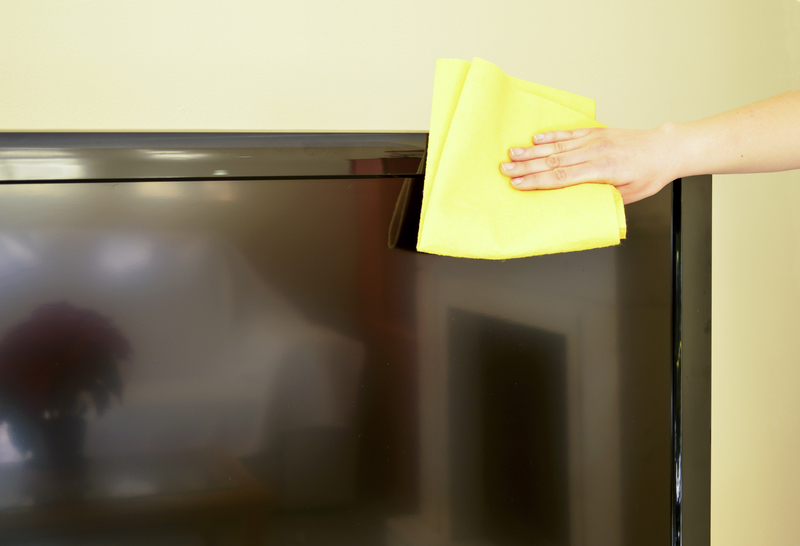Learn How to Safely Clean Mould from Window Sills
Posted on 04/06/2025
Learn How to Safely Clean Mould from Window Sills
Mould growth on window sills is a common issue in homes, especially in areas prone to high humidity and condensation. If left untreated, it not only mars the appearance of your windows but can also pose health risks. Learning how to safely clean mould from window sills is essential for maintaining a healthy and attractive living environment. In this comprehensive guide, we'll walk you through everything you need to know--from understanding what causes mould, to step-by-step instructions for safe cleaning, and tips on preventing future outbreaks.
Understanding Window Sill Mould: Causes and Risks
Before diving into how to clean mould from window sills, it's important to know what causes it and why removal is necessary. Mould is a type of fungus that thrives in moist, humid environments. Window sills are particularly susceptible because they tend to collect condensation, dust, and organic material.
Main Causes of Mould on Window Sills
- Excess Moisture: High humidity or condensation from temperature differences indoors and outdoors.
- Poor Ventilation: Lack of air circulation can trap moisture, creating a hospitable environment for mould growth.
- Dirt and Dust Accumulation: Organic debris provides a food source for mould spores.
- Leaking Windows: Improper sealing allows rainwater or melted snow to seep in.
Understanding these causes is the first step in preventing and addressing the formation of mould on window sills. Prompt action protects not only the structure of your home but also your health.
Health Risks Associated with Mould
- Allergic reactions (sneezing, coughing, itchy eyes)
- Aggravation of asthma symptoms
- Irritation of the lungs and other respiratory problems
- Potential for more severe reactions in people with weakened immune systems
If you notice any signs of black mould on window sills, take it seriously and remove it as soon as possible with proper precautions.

Signs of Mould on Window Sills
Spotting window mould isn't always straightforward. It can sometimes appear as tiny, black, green or grey specks, or as larger stains that spread across the surface and into the crevices of wooden or vinyl sills. If you notice a musty odour near the windows, this could also indicate hidden mould.
Common Visual Indicators:
- Discoloured Spots: Black, green, brown or white patches
- Peeling or Bubbling Paint: Mould growth underneath can cause the paint to lift
- Warped or Deteriorating Wood: Prolonged exposure to moisture and mould can damage the sill
- Musty Smell: An earthy, stale scent is a sign of mould spores in the air
Safety First: Precautions Before Removing Mould
Cleaning mould from window sills requires preparation to avoid exposure and prevent the spread of spores throughout your home. Mould spores can easily become airborne, so it's essential to minimize health risks as you clean.
Protective Equipment Needed
- Rubber gloves - to avoid skin contact with mould and cleaning agents
- Protective eyewear - to protect your eyes from splashes and spores
- Face mask or respirator (N95 or higher) - to avoid inhaling mould spores
- Old clothes - as they may become contaminated and need thorough washing
If the affected area is larger than 1 square metre, or if the mould returns repeatedly, consider seeking professional help as the problem may be more extensive than it appears.
Step-by-Step Guide: How to Safely Clean Mould from Window Sills
Here's a step-by-step process for safely removing mould from window sills and restoring your windows to their former clarity and cleanliness.
Step 1: Gather Your Supplies
- Protective equipment (as listed above)
- Spray bottle
- White vinegar or hydrogen peroxide (do not mix these chemicals together)
- Mild detergent (optional)
- Soft brush or non-abrasive scrub sponge
- Microfiber cloths or disposable paper towels
- Bucket of warm water
- Plastic bag for discarding contaminated materials
Step 2: Prepare the Area
- Open nearby windows for improved ventilation and to help dissipate airborne spores.
- Lay down an old towel or plastic sheeting below the window sill to catch drips and debris.
- Remove blinds, curtains, or other window furnishings that could get in the way or become contaminated.
Step 3: Apply a Mould Removal Solution
- Fill a spray bottle with undiluted white vinegar or a 3% hydrogen peroxide solution.
- Generously spray the affected area and allow it to soak for at least 10-15 minutes. *This kills most mould spores and loosens their grip on the surface.*
Note: Do not mix vinegar and hydrogen peroxide together. Use only one product at a time. For those who prefer commercial solutions, use a dedicated mould remover for window sills and follow the manufacturer's instructions.
Step 4: Scrub Away the Mould
- Use a soft-bristled brush or a non-scratch sponge to gently scrub the area. Take care not to damage the finish of wooden or painted sills.
- Wipe up the loosened mould and cleaning solution with microfiber cloths or disposable paper towels.
- Rinse your cloth or brush often in a separate bucket of clean water to avoid spreading spores.
Step 5: Rinse and Dry Thoroughly
- Once the visible mould is removed, wipe the surface with a clean, damp cloth to remove any remaining residue.
- Follow up with a dry cloth to thoroughly dry the window sill.
- Moisture is a key factor in mould regrowth, so ensure the area is completely dry.
Step 6: Dispose of Contaminated Materials
- Place any used paper towels, disposable gloves, and cleaning cloths in a sealed plastic bag before disposing in the trash.
- Wash non-disposable items like sponges and brushes with hot water and detergent, or discard if necessary.
Optional: Treat with a Mould Inhibitor
To help prevent future mould growth on your window sills, spray the clean surface with a solution of 1 part vinegar to 1 part water, or use a commercially available anti-mould spray. Let it air dry without wiping.
Natural Remedies and Alternatives
Some homeowners prefer natural and chemical-free cleaning solutions for removing window sill mould. These methods can be effective for light infestations.
- Baking Soda Paste: Mix baking soda with a small amount of water to form a paste, apply to the mouldy area, scrub gently, and rinse.
- Lemon Juice: The acidity of lemon juice can help break down mould. Squeeze lemon juice directly onto the affected area, allow it to sit, then wipe away.
- Tea Tree Oil Solution: Combine 1 teaspoon of tea tree oil with 1 cup of water in a spray bottle. Spray, wait, then clean as usual.
While natural remedies for cleaning window mould are safe and generally effective for minor cases, severe growth requires stronger disinfectants or professional assessment.
How to Prevent Mould from Returning on Window Sills
After you've learned
Five Easy Mould Prevention Tips:
- Control Indoor Humidity: Use dehumidifiers and exhaust fans in areas prone to moisture. Keep humidity below 60% when possible.
- Improve Ventilation: Open windows regularly, especially after showers or cooking, to allow moist air to escape.
- Repair Window Leaks: Inspect window seals and caulking regularly, replacing as needed to keep water out.
- Clean Regularly: Wipe down window sills, tracks, and frames with a mild cleaner to remove dust and moisture.
- Monitor & Respond Quickly: As soon as you spot condensation or suspect a leak, address it before mould has a chance to take hold.
For areas prone to repeated window sill mould, consider using anti-mould paint or coatings specifically designed to resist moisture and fungi.
When to Call a Professional
If you encounter large areas of mould, visible damage to window frames, or if the mould returns after repeated cleaning, it's best to consult an expert. Professional mould remediation technicians can identify hidden sources of moisture, safely remove extensive infestations, and advise on long-term solutions.
Particularly black mould (Stachybotrys chartarum) can release mycotoxins that are potentially harmful, especially to children and pets. When in doubt, always err on the side of caution.

Frequently Asked Questions: Cleaning Mould from Window Sills
Is vinegar or bleach better for cleaning mould?
Both vinegar and bleach can kill mould, but vinegar is often preferred for cleaning window sill mould because it is non-toxic, won't damage most surfaces, and is safer for indoor air quality. Bleach should only be used with proper ventilation and never mixed with vinegar or ammonia.
How do I stop condensation on window sills?
Condensation can be reduced by:
- Increasing ventilation (using fans or cracking open windows)
- Using dehumidifiers to keep indoor moisture levels under control
- Improving insulation around windows to minimize temperature differences
- Installing double-glazed windows for better thermal efficiency
Are there special cleaners for window frame mould?
Yes, many brands offer anti-mould sprays or foam cleaners designed for window sills, frames, and tracks. Look for products labeled as effective against fungus, mildew, and mould.
Conclusion: Keep Your Window Sills Clean and Mould-Free
By understanding the causes, risks, and best practices for safely cleaning mould from window sills, you can enjoy cleaner windows and a healthier home. Regular maintenance and vigilance are the keys to preventing future mould outbreaks. Remember to always prioritize safety, use recommended cleaning techniques, and address sources of moisture right away.
If you're proactive, you can keep mould off your window sills for good and enjoy cleaner air and brighter natural light year-round!




